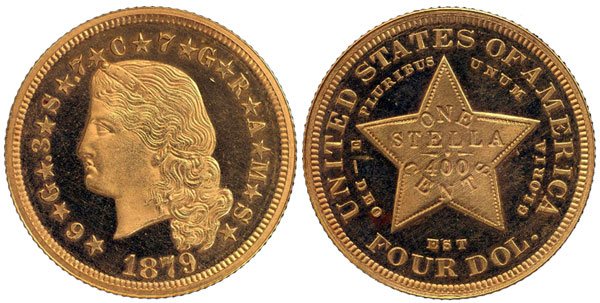Guide to U.S. Stella Four Dollar Gold Coins
Stella Gold Coins were struck in limited numbers in 1879 and 1880 for the purpose of exploring the possibility of a four dollar gold coin for use in international trade. These coins are technically patterns, however the relatively widespread availability of one of the varieties and the popularity of the designs has led the coins to be listed alongside regular issues in most guide books. Gold Stellas have become well known and are in high demand from collectors, leading the three rare varieties to command lofty prices at the auction block.

By the 1870’s worldwide commerce had reached a higher level than ever before. Trading was brisk, with plenty of shipping going on between Europe, the United States, and Asia, with most of the payments in the form of gold coins. In the case of the United States, double eagles were often the most convenient since they were the largest denomination struck by the United States Mint. However, in Europe smaller sized gold coins were often preferred, such as the French 20 franc pieces, Austrian 8 florins, Spanish 20 peseta, and Italian 20 lire. These various currencies often fluctuated in value in relation to one another, due to changes in the exchange rate as well as the price of gold.
Several countries had sought to establish a single, universal monetary issue that would translate easily across international currencies. Both the United States and France had issued a number of patterns for that purpose. Most notable was the so-called “Bickford Eagle” (named after Dana Bickford, who proposed the idea to the Mint), issued in 1874 and not only denominated in United States Dollars, but also French Francs, Dutch Guilders, German Marks and several other currencies. The idea was that plainly stating the weight and purity of the coins as well as the exchange rate would make commerce easier in those countries. However, due to ever changing exchange rates, the project was soon deemed a failure.
The Stella Gold Coins would represent another attempt at an American international currency, following the suggestion of John A. Kassson, former chairman of the United States House Committee on Coinage, Weights, and Measures. The four dollar gold coins would have their metallic content stated in the metric system and have the approximate value of the smaller gold coins circulating in Europe. A relatively large number of pieces were struck and distributed in 1879. Demand appeared high, and soon Mint officials started striking more, across two different dates and varieties. While some of the pieces were true patterns distributed to members of Congress, others were struck for the profit of Mint employees, who sold the pieces for $6.50 a piece to collectors.
There were two distinct varieties of the Gold Stella stuck for both years of issue. The first variety carries an obverse design by William Barber featuring an image of Liberty facing left, with her hair flowing down to her shoulders. Around this image is an inscription punctuated by stars, reading “*6*G*.3*S*.7*C*7*G*R*A*M*S*”. This reads as “6 grams of gold, .3 grams of silver, and .7 grams of copper, weighing 7 grams”. At the base of the design is the date, slightly curved. The second variety carries an obverse designed by George T. Morgan, with an image of Liberty facing left with her hair coiled atop her head.
The reverse of both varieties features a five-pointed star containing the words “One Stella” and “400 Cents”. The name of the coins is derived from this star, as the word “Stella” is Latin for “star”. Additional inscriptions include “United States of America”, “Four Dol.”, “E Pluribus Unum”, and “Deo Est Gloria”.
In addition to the Stellas struck in gold, patterns were also struck in aluminum, copper, and white metal. Although these other compositions may have only a few examples known to exist, they often trade for a fraction of the value of the gold versions. Generally speaking, no matter in which metal the pieces are struck, the Flowing Hair design is slightly more affordable and available than the Coiled Hair design, due to higher collector demand for the latter design.

